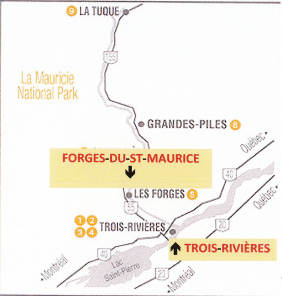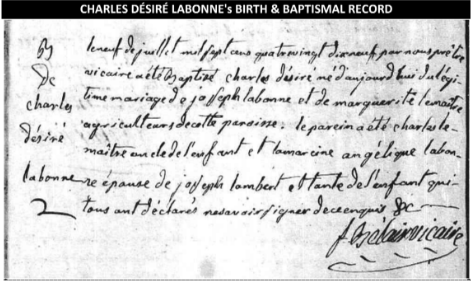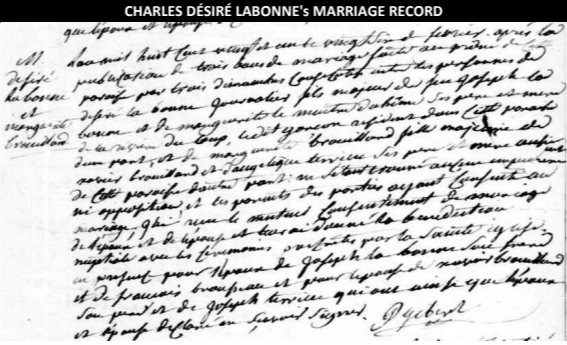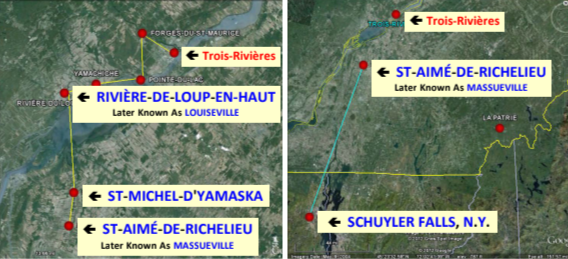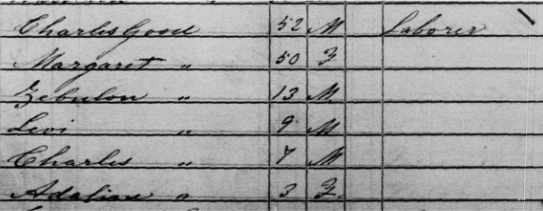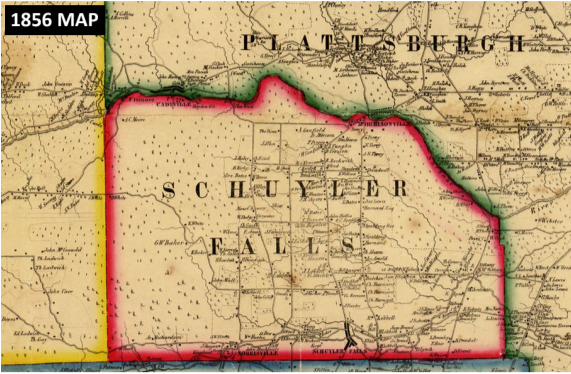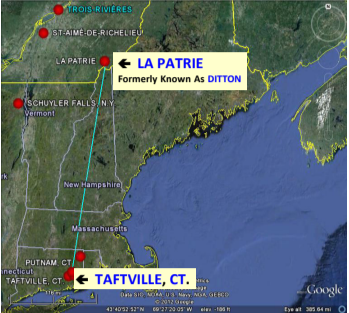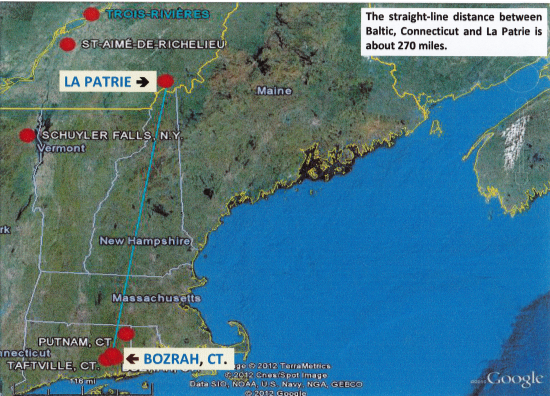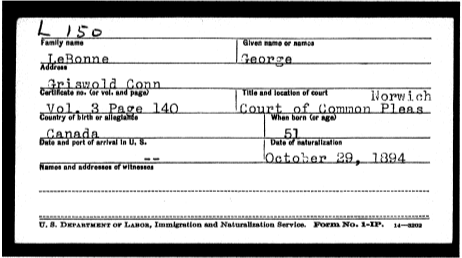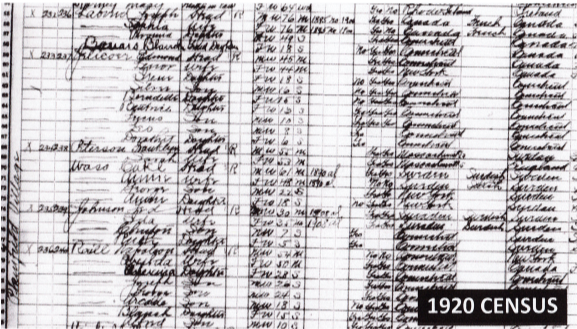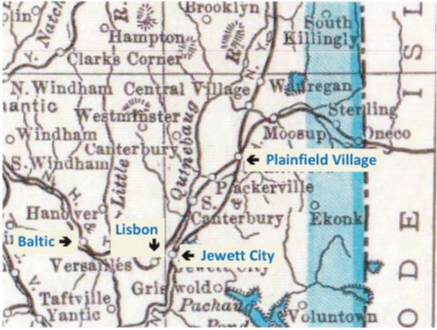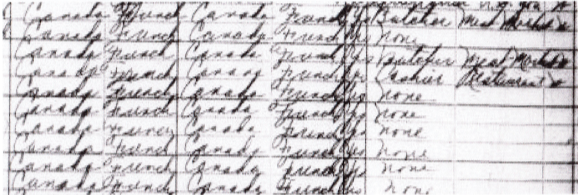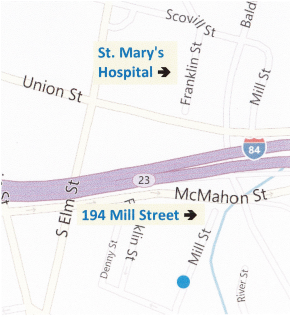LABONNE FAMILY HISTORY
A GENEALOGICAL MANUSCRIPT
Research, Composition, & Editing by Ron F. Cormier
© 2013 Naugatuck, CT
All Images Were Extracted From Internet Web Pages. Images May Be Subject To Copyright. All Images Used For Non-Profit Genealogical Purposes Only
All Rights Reserved
This Manuscript Is Subject To Errors And Omissions
A PATRILINEAL LINE OF DESCENDANCY
Pierre LaBonne
BORN c1719 IN BOURBONNAIS, FRANCE
~ FATHER OF ~
Joseph LaBonne
BORN IN 1744 IN POINTE-DU-LAC, QUEBEC
~ FATHER OF ~
Charles Désiré LaBonne
BORN IN 1799 IN RIVIERE-DU-LOUP-EN-HAUT, QUEBEC
~ FATHER OF ~
Georges LaBonne
BORN IN 1822 IN ST-MICHEL-D'YAMASKA, QUEBEC
~ FATHER OF ~
Georges LaBonne, Jr.
BORN IN 1844. IN ST-AIME-DE-RICHELIEU, QUEBEC
~ FATHER OF ~
Georges LaBonne, III
BORN IN 1875 IN LA PATRIE, QUEBEC
~ FATHER OF ~
Hilaire Joseph (Hy) LaBonne
BORN IN 1910 IN NEW BEDFORD, MASSACHUSETTS
~ FATHER OF ~
Robert Henry LaBonne
BORN IN 1936 IN BRIDGEPORT, CONNECTICUT
~ FATHER OF ~
Robert Henry Labonne, Jr.
BORN IN 1959 IN WATERBURY, CONNECTICUT
~ FATHER OF ~
Robert Henry Labonne, III
BORN IN 1989 IN TORRINGTON, CONNECTICUT
WHAT'S IN A NAME?
In researching French-Canadian genealogy, it's nearly impossible not to stumble upon at least one ancestor(typically several, sometimes dozens) with a dit name — which, on occasion, may make it more challenging, sometimes even frustrating, to connect one generation with another.
It's a well-documented fact that many of Québec’s early settlers were unable to read and write, leaving missionary priests and census enumerators with no other option than to record names as they sounded; hence, there were often several spelling variations for the same name. Carreau, for example, might be found in some old documents as Careau, Caro, or Carot. In later years, after Canada came under British control, some French surnames were anglicized. For instance: LeBlanc became White, Lévesque became Bishop, Boisvert became Greenwood, and Labonne became Good. Other names were simply bastardized by English-speaking census takers who found it difficult to understand French pronunciation — Albert was recorded as Allbear, Nadeau as Nado, and Gagnon as Gonyou. But the widespread use of dit names poses an entirely different problem for French-Canadian genealogists.
A form of the verb dire, the French word dit (pronounced dzee) simply means said or called or known as; and in genealogical sources, it's commonly inserted between a person's proper and ‘alternate’ surnames — using the feminine version dite (pronounced dzeet) if the subject is a girl or a woman. For example, Jeanne LeRouge had adopted the use of the name JeanneSaint-Denis, thus she became known as Jeanne LeRouge dite Saint-Denis. Bear in mind, however, that a dit name was not an ‘alias’, but rather an ‘alternate surname’ — nothing more, nothingless.
Many seventeenth- and eighteenth-century French-Canadians used (or were known by) a dit name; and it became quite common and acceptable to adopt one, for whatever reason one might choose — such as
(a) to identify the village or region in France from which he or she had emigrated [e.g. Bernard Huret dit Rochefort, the Bernard Huet who came from Roquefort], or
(b) to point out a unique physical characteristic or personal trait [e.g. Louis Carreau dit Lafraicheur, which may have meant that he was calm cool headed man — that he was youthful, perhaps energetic], or
(c) to describe the land on which one had settled [e.g. Jacques Houde dit Desruisseaux, the Jacques Houde who lived near the stream or creek], or
(d) to honor parents or even an adoptive family in which one may have been raised [e.g. Marie AnneJalbert dite Gastonguay, the daughter ofGaston Guay or of the Gaston Guayfamily ].
The toughest stumbling block for genealogists — the proverbial brick wall — is that dit names were often carried on from one generation to the next; and with the passage of time, some French-Canadiansarbitrarily chose to drop the use of their original ancestral surname — passing on, to future generations, a completely different family name (the dit name alone). Today, for example, some of Jacques Houde's male descendants go by the name Desruisseaux — though their surname is really Houde. Similarly, many of today's Labonne families in upstate New York carry the name Good — an anglicized version of the original surname(because, translated, the French word bonne is good).
LaBonne
TEN GENERATIONS OF FATHERS & SONS
Pierre LaBonne
BORN IN FRANCE - IMMIGRATED TO AMERICA
PIERRE LABONNE's marriage record clearly states that he was a native of France. A son of GERBERT and MADELEINE (BERTON) LABONNE, he hailed from the parish-town of Duchesne (in the Diocese of Moulins) which was located in the ancient province of Bourbonnais in central France, about 160 miles south of Paris. Little else is factually known about this French immigrant's early years, though some sources suggest that Piérre LaBonne (sometimes referred to as Piérre Baune) was born circa 1719 and emigrated from France as a young man.
It was on Friday, July 27, 1739, that Piérre Labonne, then about twenty years of age, married sixteen-year-old MARIE MADELEINE DENEVERS dite BOISVERT, the eldest of 13 children, born c1723 to FRANCOIS DENEVERS dit BOISVERT and his wife MARIE MADELEINE (PICHE). Named after her mother, Madeleine grew up on the south side of the St-Lawrence River in a small village called Ste-Croix; but by 1738, Madeleine's father had moved his family to St-Maurice. In the late 1730s, Canada's first iron foundry had been established in a new mission-parish which was officially dubbed Forges-du-St-Maurice — on the north side of the St-Lawrence about eight miles inland from Trois-Riviéres. There, Francois Denevers went to work in the forges as a blacksmith, where he likely met Piérre Labonne — a young man who by the turn of the decade would become his son-in-law.
Piérre and Madeleine's wedding took place at L'Eglise-de-L'Immaculée-Conception in Trois-Riviéres, Québec. The couple was united in marriage by Frére Augustin Quintal — a Récollet priest who from 1735 to 1743 had been assigned the task of establishing the mission-parish in nearby St-Maurice. Signing as witnesses in the church register were three Frenchmen, all of whom worked at the foundry: Cressé [ Joseph-Claude Poulin de Courval-Cressé, whose family was in charge of the forge operations], Champagne [Piérre Orion dit Champagne, a blacksmith], and Delorme [ Jean-Baptiste Delorme, a hammerman ], which strongly suggests that here in America Piérre LaBonne had taken a job as an ironworker at the forges (today, a National Historic Site of Canada open to the public).
In the year of Our Lord 1739, this twenty-seventh day of July, after the announcement of three banns at the parish masses, between Piérre Labonne, son of Gerbert Labonne and Madeleine Berton, his father and mother of the parish of Duchesne, Diocese of Moulins, in Bourbonnais [France], said Pierre Labonne being a single man today of the parish of Trois-Riviéres, and Marie Madeleine DeNevers, daughter of Francois DeNevers and Madeleine Piché, her father and mother, a single woman also of Trois-Rivieres, and having found no impediment to this marriage, I the undersigned priest, a Recollet missionary of Forges St-Maurice and first pastor of the parish of Trois-Riviéres, having received their mutual consent to marry, gave them the nuptial blessing in accordance with the ceremony prescribed by Our Holy Mother the Church, in the presence of the undersigned witnesses ...
The following year, Piérre and Madeleine's first child, Marie Magdeleine Baune, was christened in the same church where they had been, married; and their family eventually grew to include 6 more children. On June u, 1741, an old notary record verifies that Piérre Labonne, an employee of La Compagnie des Forges du St-Maurice, had purchased a parcel of land in the seigneury of Tonnancour ( better known as Pointe-du-Lac) from Etienne and Angélique Talonau; and it was there, just on the outskirts of Trois-Rivieres, that Pierre decided to settle and raise his family. As was typical then, Pierre’s lot has three arpents of frontage on the river ( almost 600 feet); it extended twenty arpents deep ( nearly three-quarters of a mile ); and it totaled just over fifty acres in size.
Altogether, Piérre and Madeleine LaBonne had four boys and three girls — from eldest to youngest: Madeleine (1740), Nicolas (1742), Joseph # 1 (1744), Marie Josephte (1746), Joseph # 2 (1747 / died at age 1), Angélique (c1749), and Jean Frangois (1752). Sadly, however, Madeleine's life was cut short at age thirty-one, as church records confirm that she was buried on November 15, 1754, in the parish cemetery at Forges-du-St-Maurice. Given her age, one might presume that her death was related to complications arising from pregnancy or childbirth. Married for just fifteen years, Pierre was in his mid thirties when he took on the responsibility of raising six young children on his own — the youngest barely two and the eldest only fourteen.
Like his wife, Piérre was also denied the joys of a long life; and though his burial record eludes genealogists, his eldest daughter's marriage in 1761 documented the fact that both of her parents were deceased. This leaves us to surmise that Piérre was probably in his early forties at most when he passed away.
To his credit, however, the LABONNE name in North America has survived for three centuries — having been passed on from one generation to the next through the many who have descended from his three married sons: Joseph #1, Nicolas, and Jean Francois. Of the thirteen grandsons who carried the Labonne name, nine are known to have married and perpetuated their immigrant grandfather's legacy.
Joseph LaBonne
2nd GENERATION - SON of PIERRE LABONNE
BORN IN AMERICA
The elder JOSEPH LABONNE (#1) was born on February 19, 1744, in the former village of Pointe-du-Lac, just west of Trois-Riviéres. He was christened the next day at L'Eglise- de-La-Visitation by Frére Denys Baron — a Récollet missionary priest who ten years later celebrated the first Mass on record in what later became the city of Pittsburgh, Pennsylvania. The parish register at Trois-Riviéres also shows that Joseph's godparents were Joseph Pothier and Marie Anne Dupont, who were probably friends of the family.
Today, 20 February 1744, was baptized by me, Récollet missionary priest of the parish of La Visitation, Joseph, born the 19th of this month, son of Pierre Bonne [sic] and Marie Boiver [ sic ], his father and mother. The godfather was Joseph Potie [sic], the godmother Mariane Dupont [sic], who [all] stated that they couldn't sign [their names] [as witnesses] to this entry.
As a young man Joseph LaBonne chose to remain close to home. It was in early 1777 when Joseph, just a week shy of his thirty-third birthday, married his first wife — twenty-year-old Marie Josephte Laure, an Acadian girl who along with her family had been deported from Nova Scotia during Le Grand Dérangement). The couple settled in a town called Yamachiche about fifteen miles southwest of Trois-Riviéres; but sadly their marriage would be very short-lived. On November 27 of that same year, Joseph's wife gave birth to a baby girl who nine days later was baptized Euphrosine Labonne; but Marie Josephte had died during childbirth and was buried the same day. Joseph was left to shoulder the responsibility of raising a newborn daughter — with help, no doubt, from family and friends; and seventeen years would pass before he met and married his second wife, from whom this line of Labonnes was descended.
It was on the third of March in 1794, just a week after he'd turned fifty, that Joseph LaBonne exchanged wedding vows with nineteen-year-old MARGUERITE LEMAITRE dite DUHÊME at L'Église-de-St-Antoine-de-Padou — a few miles west of Yamachiche in a village then known as Riviére-du-Loup-en-Haut. Marguérite had been born in Yamachiche, a daughter of ALEXIS LEMAITRE dit DUHEME and MARGUERITE (LESIEUR dite DESAULNIERS ); and she was baptized there on November 25, 1774, at L'Eglise-de-Ste-Anne.
Marriage of Joseph Labonne and of Marguérite Lemaitre dite Duaime. The year 1794, the third of March, after the announcement of a marriage bann at the parish mass of St-Antoine of Rivière-du-Loup, between Joseph Labonne, widower of the late Josette Laure [ sic ], of this parish; and Marguérite Lemaitre, daughter of the late Alexis Lemaitre dit Duaime [ sic ], and of the late Marguérite deSaunier [ sic ], her father and mother, also of this parish, and having found no impediment or opposition, the parties were given a dispensation of two banns by Monseigneur St-Onge, the bishop's deputy in Trois-Riviéres and undersigned pastor of said parish, having received their mutual consent to marry, gave them the nuptial blessing in accordance with the prescribed form of Our Holy Mother the Roman Catholic Apostolic Church, and in the presence of Charles Grenon, witness for the groom, and of Charles [ illegible ], witness of the bride, and many other relatives and friends …
Together, Joseph Labonne and his young wife would have thirteen children — seven boys and six girls (five of whom died as infants ), all born in Riviére-du-Loup. Their first child, an unnamed boy born in 1795, died at birth; and he was followed by Joseph Jr. (2796), an unnamed girl (1798/died at birth), Charles Désiré (1799), Clothilde (1801), Julie #1 (:802/died nine months later), Marguérite Christine (1803), Julie #2 (:804/died seven months later), Antoine (1806), Georges (1807), Joachim (1810), Sophie (1812), and Elie (1814/died at age one). Ol' Joe Labonne was seventy years old when his last child was born — his wife, almost forty; and he was probably quite confident that his five surviving sons would perpetuate the family name in North America.
On January 23, 1819 at age seventy-five, Joseph Labonne, who had been a farmer all his life, passed away in Riviére-du-Loup ( now known as Louiseville ), the village which had become his adopted home. He was laid to rest in the parish cemetery on the twenty-fifth, leaving behind his forty-four-year-old widow, his eldest daughter Euphrosine (age 41 ), and eight children from his second marriage (ages 6 to 23). At the time of his death, Joe and his wife were five weeks away from observing their silver wedding anniversary — a celebration which wasn't meant to be.
The year 1819, the twenty-fifth of January, by the undersigned priest, was buried in the cemetery of this parish the body of Joseph Labonne, farmer [ agriculteur] of this parish, husband of Marguérite Lemaitre dite Duheme, died the twenty-third of the present month, age seventy-five years, present at this burial [as witnesses] were Henri Dionne [ and | Jean Marie Boucher, who stated that they couldn't sign [their names] [as witnesses] to this entry.
Delaunay [Louis Delaunay], Priest
It appears that, in her later years, the widowed Madame Labonne eventually took up residence in the home of her youngest son Joachim, who had married a woman from St-Guillaume d'Upton on the south side of the St-Lawrence River — halfway between Trois-Riviéres and Montréal. Marguérite, who survived her husband by two decades, died on October 22, 1840, at age sixty-five, and was buried on the twenty-fourth in the parish cemetery of St-Guillaume.
Joseph's children became the first of the Labonnes to leave the immediate surroundings of Trois-Riviéres, spreading the family name to other parts of Canada and to the United States. Research indicates that his eldest son, Joseph Jr., eventually planted his roots in Minnesota, and that Charles Désiré [ the next generation in this line of descendancy ] established the LaBonnes in upstate New York. Their brother Antoine moved his family to Wisconsin; Georges (a grand-uncle of Georges Labonne the meat-cutter ) immigrated to Connecticut; and the youngest brother, Joachim, later settled in Massachusetts. Joe Labonne's family was on the move in many different directions and his father's name would assuredly live on for generations to come.
FOOTNOTE
Joseph Labonne's first wife, Marie Josephte Laure, was a great-granddaughter of Julien Laure dit Lamontagne — who, as a teenager, had emigrated from France and settled in Acadia (today's Nova Scotia). Coincidentally but not surprisingly, Julien Laure was a great-great-great-great-great-great-grandfather of Lucille (Simoneau) Cormier; thus, Marie Josephte and Lucille were distant cousins.
After settling in Acadia, Julien Laure had married a girl named Anne Girouard, a younger sister of Catherine Girouard — who was married to Thomas Cormier, the progenitor of the Cormier family in America and great-great-great-great-great-great grandfather of Oneil J. Cormier. Thus, Marie Josephte and Oneil were also distant cousins.
In French-Canadian Circles of yesteryear, it was indeed a very small world.
Charles Desire LaBonne
3rd GENERATION - GRANDSON of PIERRE LABONNE
ESTABLISHED THE LABONNE FAMILY IN UPSTATE NEW YORK
Born on July 9, 1799, in Rivière-du-Loup-en-Haut, CHARLES DESIRE was the fourth child of Joseph and Marguérite Labonne; but two of his three elder siblings had died at birth. He was christened in the same church where his parents had married five years earlier, L'Eglise-de-St-Antoine-de-Padou, the baptismal record stating that one of his uncles (Charles Lemaitre ) stood as godfather and a grand-aunt (Angélique Labonne, the wife of Joseph Lambert) served as godmother.
The ninth of July, 1799, by the assistant pastor was baptized Charles Désiré, born today of the legitimate marriage of of Joseph Labonne and Marguérite Lemaitre, farmers [ agriculteurs| of this parish. The godfather was Charles Lemaitre, the infant's uncle, and the god-mother Angélique Labonne, wife of Joseph Lambert and the infant's aunt, all of whom stated that they couldn't sign [their names] [as witnesses] to this entry.
F. Belair [Francois Plessis-Bélair], Assistant Pastor
Charles, sometimes referred to as Désiré, grew up on the family farm in Riviére-du-Loup; but it appears that as a young adult he decided to explore new options on the south shore of the St-Lawrence River. It was there in the spring of 1820 in St-Michel-d'Yamaska that Charles Labonne and his wife Marguérite were named as godparents to Angélique Robidoux ( Marguérite’s niece ). Nine months later in that same village, records show that twenty-one-year-old Désiré Labonne and nineteen-year-old MAR-GUERITE BROUILLARD officially became husband and wife in the eyes of the Catholic church. The nuptial blessing took place on a Monday — February 26, 1821; but the couple had been previously married in a civil ceremony, probably during an absence of the resident priest. Like his father before him, Charles would add another fourteen names to the Labonne family tree; but his wife Marguérite was well-accustomed to a crowded home. Born on September 17, 1801, a daughter of FRANÇOIS-XAVIER BROUILLARD and ANGELIQUE ( THERRIEN ), she was no stranger to large French families— having grown up with seventeen brothers and sisters. As the saying goes: the more, the merrier.
Marriage of [Charles] Désiré Labonne and Marguérite Brouillard The year 1821, the twenty-sixth of February, after the announcement of three banns of marriage were made in this parish on three consecutive Sundays, between the persons of Désiré Labonne, a laborer [ journalier |, adult son of the late Joseph Labonne and Marguérite Le-maitre Duhéme, his father and mother of Riviére-du-Loup, said young man residing in this parish, and of Marguérite Brouillard, adult daughter of [ Frangois] Xavier Brouillard and of Angélique Terrien [sic], her father and mother of this parish, and having found no impediment or opposition, and the parents of the parties consenting to the marriage, and having received the mutual marriage consentment from the groom and the bride, the nuptial blessing was given to them with the ceremony prescribed by the Holy Church, in the presence (for the groom) of Joseph Labonne, his brother, and Frang¢ois [illegible], and in the presence (for the bride ) of [Frangois] Xavier Brouillard, her father, and Joseph Terrien [sic], who with the groom and the bride stated that they didn't know how to sign [their names as witnesses to this entry].
P. Gibert | Piérre Gibert, Priest]
Charles LaBonne Jr., had been born on February 9th, 1821, two weeks prior to his parents’ church wedding; and between 1821 and 1848 thirteen more children arrived. The Labonnes would eventually have nine sons and five daughters (eleven of whom survived childhood) — nine born in St-Michel-d'Yamaska, three in St-Aimé-de-Richelieu, and the last two in New York state. In the order of their birth, Charles and Marguérite's children were Charles Jr. (1821 / died at age 11), Georges (1822), Francois (1824), Christine (1826), Michel (1828), Maxime (1830), Emélie (1832), Marguérite (1834), Génévieve (1836 / died at birth), Eusebe Zébédée (1837), an unnamed boy (January /1841, died at birth), Olivier (December /1841), Charles #2 (c1843), and Adéline (c1848).
Sometime in 1836 (or possibly in the spring of 1837), Charles Labonne moved his family about eight miles south to a village then known as St-Aimé-de-Richelieu (now often referred to as Massueville ). Though Charles was a farmer like most French-Canadian men, his occupation is noted in several church records as journalier — typically a laborer, one who works for a daily wage. In St-Aimé, Madame Labonne gave birth to three of her youngest children; but by the end of 1841, not long after the birth of their son Olivier, Charles decided that greener pastures awaited him on the other side of the Canadian border.
It was probably in 1842 ( but certainly no later than the spring of '43 ) when the LaBonne clan trekked nearly a hundred miles south and west to a small town called Schuyler Falls in the northeastern corner of New York state — about forty miles south of the U.S.-Canadian border. It had been only a century since Piérre Labonne established his name in Canada; but Charles, like his grandfather, took a leap of faith and ventured off to the United States. Along with eight of their nine children (the youngest just an infant and the eldest about eighteen ), Charles and Marguérite settled in Schuyler Falls which was then a suburb of Plattsburgh — and they never looked back. Plattsburgh at the time was a growing industrial port city on Lake Champlain with droves of Canadians flocking there to work; and it's estimated that in the 1840s about one third of its population was French. The land of opportunity wasn't, however, as welcoming as the Labonnes might have expected. English-speaking locals looked down on the French immigrants and thought them to be both ignorant and arrogant. There was also a great deal of animosity between French-Canadian and Irish-Canadian immigrants as both groups vied for the same jobs; and though the French (to the annoyance of others ) held fast to their family roots and ethnic customs, they were a hardworking people who were determined to prove themselves — even if it meant working long hours for substandard wages and allowing their Anglo counterparts to dictate all the rules.
At the time of their move, Charles and his wife were in their early forties; but by summer's end in 1843, Marguérite gave birth to another son and named him Charles — in memory, no doubt, of their eldest child (Charles Jr.) who had died in Québec as a young boy. Although the family had arrived in the U.S. en masse, one son (twenty- year-old Georges ) chose to remain in St-Aimé where in November of 1843 he married and eventually raised his children. [ That son, Georges , was the one who later established his family in Connecticut — the father of George Labonne Jr. who became the family's first meat-cutter.]
Tracking this branch of the Labonne family from Québec to Schuyler Falls is both elusive and frustrating; but experienced French-Canadian genealogists know to explore every possible alternative — and in this family's case, U.S. census reports labeled them with a new name. Indeed, Charles and Marguérite Labonne and their children had become known as the 'GOOD' family in Schuyler Falls. Their French name had been anglicized; and in public records the Labonnes of New York were then and thereafter known as the Goobs. In the 1850 U.S. Census for Schuyler Falls, Charles Good, a laborer, and his wife Margaret are listed with four children at home — Zebulon [Eusebe Zébédée |, age thirteen; Levi [Olivier], age nine; Charles, age seven; and Adéline, age three — the latter two having been born in New York. In the same census in two other households are four of the Labonnes' elder children. Their daughter Christine ( who five years earlier had married Joseph Larocque at St. Peter's Church in Plattsburgh ) is listed as Christiana Rock, age twenty-four, wife of Joseph Rock (a mason) and mother of four young children. Living three doors down from Joe and Christine was Francis Good [ Francois Labonne ], a shoemaker, age twenty-six, his wife Mary [ Marie Dusseault ], and their three children, as well as Francois’ two younger brothers — Mitchell Good [ Michel Labonne ], age twenty-two, and Maxim Good [ Maxime Labonne ], age nineteen, both of whom were also shoemakers. Two of the Labonnes' younger daughters (Emélie and Marguérite ), who in 1850 would have been eighteen and sixteen respectively, appear to be unaccounted for. It's possible, however, that either or both had married by then and were enumerated in the census under a husband's surname — or that one or both had returned to St-Aimé to live with their elder brother Georges — or that both had died as teens. Additional research might reveal the fate of the two girls, though it could prove to be an exhaustive and fruitless hunt.
Thus goes the legacy of the LABONNE /GOOD family in upstate New York — future generations having thereafter adopted their Americanized name. In the 1860 census for Schuyler Falls, Charles Désiré Labonne was once again enumerated as Charles Good — a laborer, age sixty-two; his wife, Margaret, age fifty-nine, was keeping house; and the couple still had three children at home — Levi [ Olivier], a teamster, age nineteen; Charles, a farmhand, age seventeen; and Adaline [ Adéline ], age twelve — all three having attended school during the previous year.
Ten years later, the elder Labonne children were still residing in Schuyler Falls; but efforts to track down Charles and his wife (and their younger children ) were unsuccessful. It's quite possible that they had relocated to a nearby town, or that they were out-of-state visiting with their son Georges (who by then had moved to Connecticut ), or that they had returned to Canada for a time. No definitive answer could be found; but corroborating evidence shows that Charles did remain in (or return to) New York. In 1880, the U.S. Census identified numerous Good descendants still residing in and around Schuyler Falls — as well as ol’ Charles Good himself, who on the eleventh of June was enumerated as an eighty-three-year-old widowed farmer.The family matriarch, Marguérite Labonne, had passed away sometime between 1860 and 1880 — having been married to Charles for at least forty years; and because there's no mention of Charles in the 1890 census, it's assumed that he died sometime between 1880 and 1890. It's possible (even likely) that local church and civil records would reveal date-specific details of Charles and Marguérite's deaths.
For all the years that this family had lived in New York, one thing is certain — that they never forgot who they were or where they came from. They may have allowed English-speaking New Yorkers to change their family name to Good; but in the end, the name LABONNE was etched onto their gravestones. In a genealogical collection now known as the McLellan Cemetery Records, one entry clearly shows that Charles and Marguérite's son Michel Labonne (1823 - 1873) is buried in the Schuyler Falls New Cemetery on Fenton Road, along with his wife Julie Marie Reeves (1832 - 1905); and in St. John's Old Roman Catholic Cemetery in nearby Plattsburgh is a gravemarker which reads from top to bottom: LABONNE - Mary Dusseault - Wife of Francois-Xavier Labonne - Born 1827 - Died 1881.
Although Charles Désiré Labonne had successfully settled his family in the United States, it was his son Georges who established a branch of this family in Connecticut — from which many have since descended.
And the story continues —
Georges LaBonne
4th GENERATION - GREAT-GRANDSON of PIERRE LABONNE
CARRIED A BRANCH OF THE LABONNE FAMILY To CONNECTICUT
The popularity of given names runs in cycles; and in the nineteenth century the male name Georges appears to have been a favorite amongst the Labonnes. In old French Canada, the name was spelled Georges ( with a silent s on the end ); and in researching this branch of the Labonne family, one quickly finds that there were several interrelated Georges Labonnes, tasking genealogists to carefully examine historical documents in order to properly distinguish one from another.
In the Québec parish of St-Michel-d'Yamaska, an old church register reveals that this Georges Labonne, son of Charles Désiré, was born on the sixth of June in the year 1822 and christened the following day. His godparents were Piérre Badaillac dit Laplante [a grand-uncle] and Généviéve Brouillard [an aunt]. Georges was a second child; but in 1832, after the death of his eleven-year-old brother Charles Jr., he became the eldest of the Labonne siblings.
The year 1822, the seventh of June, was baptized by me, the undersigned priest, Georges Labonne, born yesterday of the legitimate marriage of Charles Labonne, farmer [ cultivateur ] of this parish, and of Marguerite Brouillard. The godfather was Pierre Laplante [ sic ], the godmother, Généviéve Brouillard, who stated that they couldn't sign [ their names] [as witnesses] to this entry.
P. Gibert [ Piérre Gibert, Priest]
Georges grew up in Yamaska, moving to St-Aimé-de-Richelieu as a young teen when his parents decided to relocate. St-Aimé was only a short distance south of Yamaska but the move played an important role in this young man's life. There, George courted a French girl who was nearly identical in age to him, Mademoiselle Mademoiselle MARGUERITE ROBIDOUX. A daughter of JEAN-BAPTISTE ROBIDOUX and CATHERINE ( BROUSSEAU ), she too had been born in St-Michel-d'Yamaska, on May 31, 1822 — less than a week before George; and both had been raised in a large French family, she being one of fifteen children. It's very possible, even likely, that the two may have played together as kids; but it appears that the Robidoux clan hadn't moved to St-Aimé until a year or so after the Labonnes.
Although Georges’ parents, along with his younger brothers and sisters, emigrated from Québec in the early 1840s, George ( then nearly twenty-one ) decided to remain in St-Aimé; and in the fall of 1843 he and Marguérite Robidoux were married there in the local church. Their wedding took place on Tuesday, November 21st ; and the couple's marriage certificate recorded the fact that the groom was a navigateur (in English, a boat pilot ). For the next fourteen years or so, the Labonnes made their home in St-Aimé-de-Richelieu; and there, between 1843 and 1857, eight children (four boys and four girls) were born to them: Georges Jr. (1844), Eléonore (1846), Salomon (1847), Joseph (1849), Xiste Odinas [later known as Denis] (1851), Marie [ later known as Azélie] (4852), Marie [later known as Aimée ] (1854), and Léocadie (1856).
Marriage of George Labonne and Marguérite Robidoux
The twenty-first of November, 1843, after the announcement of three banns of marriage were made at the parish masses, between George Labonne, a boat pilot [ navigateur], residing in this parish, adult son of the late Charles Labonne and of Marguérite Brouillard, and Marguérite Robidoux, residing in this parish, adult daughter of Jean-Baptiste Robidoux and of Catherine Brousseau, her father and mother of this parish, and having found no impediment, the undersigned priest, having received their mutual marriage consentment, gave them the nuptial blessing in the presence of Frangois-Xavier Brouillard, Odile Dufresne, Jean-Baptiste Robidoux — father of the bride, and Eusébe Robidoux — brother of the bride, who, with the groom, [stated that they] didn't know how to sign [their names as witnesses to this entry].
J.BE. Lamothe | Jean-Baptiste Esdras Lamothe] *
* Father Lamothe, the pastor at St-Aimé-de-Richelieu, passed away three months later — at age twenty-eight.
Nearby in Yamaska, Georges’ uncle — George LaBonne, a younger brother of Charles Désiré — was raising his own children; but by the mid-1850s he had moved his family to Connecticut and settled in the town of Putnam in Windham County. In Connecticut, as in other New England states, textile mills were springing up in towns and villages across the state. Jobs were plentiful and tough times in Québec drove hundreds of families out of French Canada. In the States, Canadian immigrants willingly worked long hours for cheap wages; but given that most couples had very large families (and that their children, even those as young as twelve, could go to work in the cotton mills) they bettered themselves financially in a very short time. Most considered their move to the States to be temporary, expecting that they'd eventually return to their mother country; but thousands set down new roots in the U.S. and never returned to Canada
It was sometime in 1857 or '58 when George and Marguérite Labonne packed their belongings, gathered their children, and followed Oncle Georges and Tante Catherine to Connecticut. They initially chose to settle in Bozrah, a small mill town in New London County about forty miles southwest of Putnam, where local textile manufacturers were hiring and fertile farmland was plentiful.
On June 21, 1860, the Labonnes were enumerated in the U.S. Census — living in Bozrah as (to no surprise) the 'GOOD' family: Geo. and Margaret Good, both thirty-nine years of age [sic] — he a factory worker, and she as a housekeeper. In their home were nine children. Georges Good Jr. was the eldest at age sixteen [sic], a factory worker like his father; and Ellen [Héléne] was the youngest at age two, born in Connecticut shortly after her parents had immigrated. In the same census, the Total Value of [ Georges’ ] Personal Estate was reported to be a mere $100, about $2,700 by today's standards; but he was in it for the long haul and his net worth would more than quadruple by the end of the decade.
Ten years later, the 1870 U.S. Census recorded Georges and his family as still residing in Connecticut; but it's clearly evident that this proud Frenchman had no intention of allowing any Connecticut Yankee to deny him his heritage. On the seventh of June, Georges LABONNE, a forty-nine-year-old carpenter, was enumerated along with his wife Margaret, also forty-nine, and seven of his children. By then, the family had moved ten miles north to the Baltic — located in the town of Sprague. There, just a decade earlier, the Sprague family of Cranston, Rhode Island had established a new cotton mill and simultaneously created the village of Baltic. In this census, the Total Value of [ George's ] Personal Estate had risen to $900 — the equivalent of about $14,500 today; and George and Marguérite's children were listed as follows, most of
their given names having been anglicized or bastardized by the census-taker — Solomon [Salomon], 22, a saloon-keeper; Dennis [ Xiste Odinas], 19; Osalia [Azélie ], 17; Aura [ Aimée ], 14; Leocada [ Léocadie ], 13; and Ellen [ Héléne ], 2 - all of whom (excepting Salomon ) were working in the cotton mill ; and lastly, Prudhom [ Prudent ], 9, the baby of the family, born in Connecticut and listed as attending school. The Labonnes' eldest daughter, Eléonore, had by then married and was living nearby with her husband Joseph Bréard (in the census, Joseph Beard ) and two young children; but no mention is made of the Labonnes' twenty-year-old son Joseph, and his fate remains unknown. Georges Labonne Jr., who would one day become the family's first self-employed meat-cutter, was listed as a married man, working in the cotton mill, age twenty-five [ he'd actually turned twenty-six the day before the enumeration ]; and he and his wife, twenty-six-year-old Sophia, and their two children, Sophia (3) and Esilda (1), were then living in the same house with his parents.
What complicates matters for genealogists researching the Labonne families in Connecticut is that by 1870 Georges’ uncle and aunt (the Georges Labonnes of Putnam )had also moved, along with their family, to the Baltic. In that same 1870 census report, and in that same village, was the retired sixty-six-year-old Georges Labonne, his wife Catherine, and their children — including a son named Georges Labonne Jr. who was working as a local saloon-keeper. The Labonne name was destined to live on in Connecticut for many decades to come; but major changes were fast-approaching.
As the 1870s unfolded, the U.S. economy went into a tailspin; and by the middle of the decade a severe depression led to job losses nationwide. New England's textile mills were not immune to economic woes, which resulted in lay-offs for many of their immigrant workers. Ironically, it was around the turn of that decade when Québec's legislative assembly began to fear that the identity and culture of their province was in serious jeopardy — having been shocked by the fact that in thirty years time more than half-a-million Québecois had crossed over into the United States. In 1869 the Canadian government had passed a new law which allowed and encouraged private societies to reach out to ex patriots in the U.S.; and almost immediately a newly-formed group, La Société de Colonisation du Comté de Bagot, stepped forward to support the cause. They not only had to stem the continued exodus of Québec's people but also had to come up with a plan to convince those who'd left to return home. Their timing couldn't have been more perfect.
In Compton County, Québec – just east of Sherbrooke and only about ten miles north of the U.S. border in New Hampshire – there was a sparsely populated village called Ditton which was ripe for new development; and by 1870 an unofficial plan was being hammered out to lure French expats back to their homeland – more specifically, to Ditton. With the help of an appointed agent and some of the region's concerned priests, the word was spread to emigrants in dozens of mill towns in the New England states that Québec wanted them back. Though some by then had begun to trickle back over the border on their own, it was the repatriation movement which eventually convinced thousands more to return. In rural Ditton, the Canadian government had set aside and subdivided large tracts of land and offered an attractive proposition to French-Canadians who longed to return home. For the sum of only $200, each new settler could buy a 100-acre farm, house included, with four acres of land already cleared and ready for planting; and to sweeten the pot the government offered them 100% financing with no interest — the loan to be repaid over ten year.
In 1870, Frenchman Etienne Gobeil – a longtime resident of Chestnut Hill [ Killingly], Connecticut – had traveled to Canada to explore new options; and on his return he made a decision to move his family to Ditton. A few months later, convinced that this new development was a golden opportunity, Monsieur Gobeil persuaded a friend of his – Francois Lamothe of Williamsville, Connecticut (also in Killingly) – to open a hotel business in Ditton; and thus began a small exodus by some of Connecticut's French immigrants. One might presume that either or both of these entrepreneurs knew a third man named Joseph Robidoux of Baltic, Connecticut – because in 1871 Monsieur Robidoux, along with his own family, joined Gobeil and Lamothe in Ditton and became the catalyst for the Labonne family's return to Canada. As it turns out, Joe Robidoux was Georges Labonne's brother-in-law; and the domino effect had begun.
On April 16, 1875, in a special enumeration of the colony of Ditton, Georges and Marguérite (Robidoux) Labonne are listed as having arrived there in 1873 – with five children. Georges, who was then in his early fifties, couldn't resist the opportunity. In 1874 his two married sons, Georges Jr. and Salomon, and his eldest daughter Eléonore quit Connecticut to establish their own families in Ditton; and in the fall of that year the Labonnes gathered in celebration once again when Georges and Marguérite's younger daughter Azélie married the son of Etienne Gobeil. Little did Georges know at the time that his own grandson – the Honorable Samuel Gobeil ( Azélie's firstborn – would one day serve as Ditton'’s mayor ( for fifteen years!), be elected in 1930, to the Canadian House of Commons, and later become ( for a short time in 1935 )the Postmaster General.
Georges would have also undoubtedly been proud of the fact that – nearly three centuries after his great grandfather's arrival in Trois-Riviéres — one of his descendants has just recently become the Bishop of the Diocese of Trois-Riviéres. On February 2, 2012, sixty-two-year old Monsignor Luc-André Bouchard — great-grandson of Azélie (Labonne) Gobeil — was appointed to his new position by Pope Benedict XVI. Vive les francais! Vive les Labonnes!
For the repatriated families in Ditton, 1875 was a momentous year. Around the time of the April census, the founding fathers of this growing community (including Georges Labonne, his two married sons, and his sons-in-law ) gathered for a community meeting and, Luc-Andté Bauchaid by a unanimous vote, renamed their village La Patrie — French for The Fatherland. Though each was surely grateful for the repatriation efforts of the British government, these nineteenth-century colonists weren't quite fond of the development's English name; and they made it very clear that their French culture, their French identity, and their Catholic faith would always be top priority in their lives. Thus was born the village of La Patrie, formerly known as Ditton. By summertime, the Bishop Sherbrooke had paid a visit to La Patrie, during which time the parish chapel was dedicated and given its official name — St-Piérre-de-La-Patrie.
A more comprehensive town wide census was taken on October 30 in La Patrie inaugural year, revealing that fifty-four families had settled in the village. The total population stood at 308, of which only seventy- four had come from the United States — the Labonne clan accounting for twenty-four (nearly a third) of the repatriated group. The report also offers some precious genealogical information, including the following details which pertain to Georges Labonne and his family:
Georges Labonne, pére [the father], who had emigrated from the Taftville section of Norwich, CT., owned lots #7 and #8 on rang #2; and by the autumn of 1875 he had cleared fifty acres and erected three buildings. [ The village had been laid out in a grid-like fashion, typical of early Canada, with large tracts of land parceled into lots, each tract separated by a dirt road which in French was called a rang.]
Georges Labonne, fils [the son] had emigrated from Bazrahville, CT. and purchased lot #6 on rang #2, right next door to his father. He had ten cleared acres and one building (his house ). In early 1875 his wife Sophia had given birth to another child there in La Patrie, and they had named him Georges Labonne, III (the boy who would one day marry and become the father of Hy Labonne).
Salomon Labonne came from Baltic, CT. and bought lot #14 on rang #2. He had fif-cleared acres and owned one building (his house).
Joseph Bréard, the husband of Eléonore ( Labonne ), had installed his family nearby on lot #8, rang #3 — clearing twenty acres and erecting three buildings by October of 1875. His farm was adjacent to that of Eléonore's uncle, Joseph Robidoux — who owned lot #7 next door with twelve cleared acres and three buildings.
On a broader scale, Canada's repatriation efforts in Québec had flopped. Contemporary studies have explored and explained many of the reasons for this failure; but in the end, it was simply that the majority of the province's emigrants had quickly grown accustomed to their factory jobs in the U.S. — and most weren't too keen on giving up their weekly paychecks to return to the rigors and uncertainties of farm-life in Québec.
The Labonnes, however, had come full circle; and all except for Georges Jr. chose to make La Patrie their permanent home — never returning to live in Connecticut. Georges Labonne and Marguérite Robidoux had been married for nearly forty years when, on August 26, 1882, Marguérite passed away at age sixty. Two days later her funeral mass was held at L'Eglise-de-St-Piérre in La Patrie — after which she was interred in the parish cemetery. Young as she was, she'd left behind an ever-growing family and an interesting legacy. Her husband Georges remained in La Patrie to live out his final years with his children and grandchildren nearby; and in April of 1891 the Québec Census enumerated Georges for what appears to be the last time: a sixty-eight-year-old widowed farmer, still living in La Patrie — under the roof of his youngest son Prudent. In a cursory review of the parish records at St-Piérre-de-La-Patrie, specific details of George's death and burial could not be found; but because the Québec Census of 1901 makes no mention of him, one might fairly assume that he had died between 1891 and the turn of the century. It would be his namesake, Georges Labonne Jr., who would return to Connecticut to reestablish this branch of the Labonnes — and to become the first in a long line of father-and-son meat-cutters — which more than a century later — through five generations of descendants remains a family tradition
In La Patrie, recognition of the Labonne families’ contributions to the early growth, development, and RANG LABONNE population of the French colony came in 1979 — a century after its founding. That year, the province's Commission de Toponymie (a government body responsible for the naming of streets, lakes, rivers, and such) reviewed and approved an application to name a two-mile stretch of road Rang Labonne. Running north-and-south parallel to Route 257 and the Salmon River, Rang Labonne is located about four miles northwest of the village center — mostly forest and farmland on either side of the road and sparsely populated by no more than a dozen homes. The Labonne name lives on; but La Patrie today has only 750 inhabitants (2011 Canada Census) and a search of online telephone directories shows no listings for any local Labonnes. Oddly, however, the village has become quite well-known for its production of handcrafted guitars, as shown at the following websites:
pages.usherbrooke.ca/dlaroche/histoire/history.htm, www.normanguitars.com/aboutus. html, and www.lapatrieguitars.com/intro.html. Decades pass — and times do change.
Georges LaBonne, Jr.
5th GENERATION - GREAT-GREAT-GRANDSON of PIERRE LABONNE
PERMANENTLY ESTABLISHED THE LABONNE NAME IN CONNECTICUT
Born on December 17, 1844, in St-Aimé-de-Richelieu (Québec ), GEORGES LABONNE JR. was the first child and eldest son of Georges and Marguérite (Robidoux) Labonne — Destined to become the most well-traveled of the Labonnes and the progenitor of a family meat-cutting and grocery business in Connecticut, he was christened in the village church on the day of his birth — just a week shy of Christmas Eve — by Pére Piérre Lafrance, a young priest who had recently been named as the new pastor of the parish; and his godparents (le parrain and la marraine) were Jean-Baptiste Robidoux and Généviéve Brouillard — probably his maternal grandfather and a grand-aunt.
The seventeenth of December, 1822, our undersigned priest (the pastor ) baptized George, born the same day of the legitimate marriage of Georges Labonne, farmer [ cultivateur ] in this parish, and of Marguérite Robidoux. Godfather was Jean Baptiste Robidoux; godmother, Génévieve Brouillard, who along with the [ child's ] father, stated that they couldn't sign [their names as witnesses to this entry].
Lafrance | Piérre Lafrance, Priest-Pastor]
Georges’ early years were based in St-Aimé where — as a young teen — he would have undoubtedly spent his days helping out on the family farm and playing the role of ‘big brother’ to his seven younger siblings. It was in the late 1850s when Georges Jr. was about thirteen that he moved to Connecticut — for the first time — where he became known as George GOOD. In the summer of 1860 the U.S. Census enumerated Georges as a sixteen-year-old factory worker (though at the time he was still six months shy of his sixteenth birthday ) living with his parents in Bozrah.
As was customary then in the New England cotton mills, Georges probably worked as many as twelve hours a day — donating his weekly earnings to the family household. Among the French-Canadians of that era, it was truly ‘one for all and all for one’; and the focus of life was la survivance (the survival of their identity and their culture ). For most, there was neither time nor need for any formal education; but after a while many — including Georges Jr. — learned to read and write. Day-to-day life was their teacher and their common goal was the betterment of the family.
Before the close of the decade George had met and married an immigrant Québecois girl named SOPHIE TOUSIGNANT dite LAPOINTE. Sophie — who had been born and baptized on March 12, 1843, in the village of St-Francois-du-Lac de Yamaska — was the daughter of Louis-NOEL TOUSIGNANT dit LAPOINTE and his wife LEOCADIE (GAMELIN dite CHATEAUVIEUX). The Tousignant family, all of whom had abandoned the use of their original surname in favor of LAPOINTE, had emigrated from Québec in or about 1858 and were also residing in Bozrah at the time of the 1860 census. Like her father and her two elder sisters, Sophie — at age seventeen — was a factory worker, helping to support her parents’ large brood; and it might be fair to assume that she and George met while working in the mills. Their marriage took place in Connecticut circa 1866; and with frugality being a way of life, the couple lived with Georges’ parents until they were able to establish themselves. The 1870 U.S. Census reveals that Georges Jr., age twenty-five, was working in the cotton mill — and that his wife Sophia was at home taking care of their firstborn children, Sophia (3) and Esilda (1). By then they had moved, along with George's family, to the village of Baltic in Sprague; but as noted in the previous chapter, their stay in Connecticut was cut short by the economic depression of the 1870s — at which time they returned to Québec and settled in the village of Ditton / La Patrie.
According to La Patrie's 1875 special censuses, Georges and Sophie had arrived in the fledgling colony in 1874 along with four children (all girls) who had been born to them in Connecticut — Sophie, Ezilda, Virginie, and Rosanna; and an asterisk indicated that Georges’ wife was expectant with their fifth child. Another old document reveals that three years earlier (on January 12, 1872), George Jr.'s father had purchased 300 acres in La Patrie — lots #6, #7, and #8 on rang #2 — though the elder Georges didn't actually move there until sometime in 1873 (waiting, perhaps, for their house to be built). It was on one of those three farm lots (#6 ) that Georges Jr. and Sophie settled — right next door to his parents. They had almost surely arrived by train and the fare had likely been paid by the Canadian government — about nine dollars per adult and seven dollars for children age seven and under. It must have been cause for a grand celebration when Georges and Sophie and the rest of the Labonne family finally arrived in La Patrie — and an even grander time when they all gathered in the fall to sing and laugh and reminisce and dance when George Jr.'s sister ( Azélie ) was married.
As winter came to a close in March of 1875, Sophie Labonne gave birth to the couple's first son — who was named Georges, after his father and grandfather; and with ear-to-ear smiles, handshakes, and hugs, the family must certainly have celebrated once again. Life was good.
Distance between Baltic and La Patrie
For the moment, George LabonneJr. was right where he was supposed to be; but living the life of a farmer was undoubtedly an arduous experience. By the end of1875, George had managed to clear some additional land, bringing his total tillable acreage to ten. In 1876, his labors continued; and by mid-summer, according to one report, George had thirty cleared acres and another building (a barn, perhaps). The boy who'd been born in St-Aimé and spent his teen years in Connecticut had adapted to his new life back in Canada — though, as the years unfolded, it seems that he wasn't quite content with being a farmer. By the end of the decade, his own family had grown to in-clude two more children — a girl and a boy, both born in La Patrie( the latter in 1879). For whatever reason, however, George and Sophie were readying themselves for yet another move.
A search of the 1881 Canadian Census leads one to initially believe that the entire Labonneclan had disappeared from La Patrie; but the report, itself, was grossly inaccurate — insofar as spelling was concerned. In La Patrie, members of this family were listed under the name LaBoune; and, although George Jr. and Sophie and their children were still mysteriously missing, a closer look at the report reveals that they had moved about thirty miles west to a town called Ascot, on the outskirts of Sherbrooke.
There, under the name LaBonnte, thirty-six-year-old George was enumerated as a laboreur — along with his wife, Sophia, and six children — which begs the question "Why the move?". Ascot was just a small village; but by the mid-1800s it had become a major player in the mining industry. There, large deposits of copper ore had been discovered and tapped; some mining companies had set up shop; and, though it's only speculation, one might conclude that George LabonneJr. had secured a job — temporarily, at least — as a worker in the mines. Farming was a way of life for most FrenchCanadian men; but it wasn't, by any stretch of the imagination, a lucrative occupation. George Jr., it would seem, aspired to become something more; and for a short time, drawing a weekly paycheck may have been part of his plan.
It was sometime in 1879 or '80 when George, then in his mid-thirties, moved his family to Ascot; but within two years, they had returned to La Patrie. In the spring of ‘8, while living in Ascot, he and Sophie had buried their two-year-old son Félix; and less than a month later, they became the parents of yet another daughter — Céléda, who was christened in the nearby parish of St-Antoine-de-Lennoxville. It wasn't, however, one of the couple's happier years — for in November, back in La Patrie, tears of sadness returned when six-month-old Céléda was laid to rest in the parish cemetery.
Except For the few documented family events which follow, little is known of George's life over the next two decades. One might surmise that he went back to tilling his fields and providing for his wife and children — all the while planning and preparing for his next move.
Recorded in the parish registers at L'Eglise-de-St-Piérre-de-La-Patrie — on the thirtieth of October in 1882 — is the marriage of George and Sophie's eldest child, fifteen year-old Sophie, to a young man named Sigefroid Paquette. This marriage record reveals the fact that the Labonnes of La Patrie had, at some point in time, learned to read and write — given that the signatures of George Sr., George Jr., and the bride appear in the original register entry. Though his daughter was young (not uncommon at the time), GeorgeJr. must have been proud to stand at the altar with her — knowing that he and his wife might soon be enjoying the company of grandchildren. It was surely a day to celebrate, though it must have also been a bittersweet occasion — the family matriarch, GeorgeJr.'s mother, having passed away just two months earlier (on August 26th).
The following June (1883), George LabonneJr. becamea father for the ninth andlast time — whenhis wife, at age forty, gave birth to another boy. In all, the Labonnes had had three sons and six daughters — the eldest four in Connecticut, the others in Canada — as follows: Sophie (1866), Ezilda (1869), Virginie (c1871), Rosanna(c1873), GeorgeIII (1875), Marie Sélima (1877), Félix Théodore (1879 / died at age 2), Céléda (1881/died at age 6 months), and Joseph Nazaire (1883 /fate unknown).
Fifteen months after their daughter's marriage (and just seven months after the birth of their last child), George and Sophie became grandparents. The date was January 26th, 1884, just weeks after George's thirty-ninth birthday. The next day, George and Sophie were named in the parish register as godparents to that grandchild — a boy, Sigefroid Paquette, Jr. — and once again, it was time to break out the cigars! In the years ahead, Sophie (the daughter) would add many more grandchildren to the family tree; but sadly, Sigefroid Jr. wasn't destined to reach adulthood — and died eight months after his birth.
Between 1884 and 1900, few documents exist to verify details of the lives of George and Sophie Labonne; but a thorough search of the church registers at La Patrie and a careful study of the information contained in early twentieth-century U.S. census reports sheds some light on the matter. Like many Francos who originally emigrated from Canada in the mid-1800s and later returned to their homeland, it appears that George and Sophie may have hovered between La Patrie and Connecticut for a number of years. It's quite possible (even probable) that they had made their way back to Connecticut by the late-1880s — staying for short periods of time while exploring new options before deciding to make a permanent move. Unfortunately, the population schedules for the 1890 U.S. Census no longer exist (having been destroyed or heavily damaged in a 1921 fire), hampering genealogical research for that period; and a dogged search of the 1891 Canada Census Failed to find any listings for George Labonne Jr., Sophie, or their younger children. Three documents do, however, confirm the fact that the Labonnes had moved back to Connecticut by the mid-1890s — possibly as early as 1887 but certainly no later than 1895.
(1) In the 1900 U.S. Census, George and Sophie's second-eldest daughter (Ezilda) was enumerated — along with her husband (NapoléonRaille) and their four children — in Jewett City, Connecticut. That same entry states that Ezilda had been born in Connecticut in February of 1869, that the couple had been married for ten years, that their eldest child (Alexina) had been born in December of 1891, and that all of their children were born in Connecticut. Being that Ezilda's husband was a Connecticut native who'd been previously listed in Connecticut census returns — and because no record of the couple's marriage is found in any Canadian church register — it's almost certain that Ezilda had married in Connecticut in 1890 or '91 (where her parents, George and Sophie, may have been living by then).
(2) In the 1920 U.S. Census (the last in which George and Sophie were enumerated), the couple indicated that they had immigrated in 1895.
(3) Lastly, the one1e key document which narrows the time frame of the Labonnes' final move to Connecticut is George's naturalization record. It was on October 29th,1894 at the courthouse in Norwich that George LeBonne[sic] proudly became a U.S.citizen — thus opening new doors for the fifty-year-old Frenchman and allowing him to set down permanent roots in a country he'd come to know and love.
With a change of venue, the story of George and Sophie fast-forwards to the turn of the century — the couple and their children having immigrated back to Connecticut where George permanently reestablished his branch of the Labonne family — and never look backed. He had labored in the Connecticut cotton mills as a young man, tilled the soil as a farmer in Québec, probably worked in the copper mines of Ascot — and finally found his niche in Jewett City. It's often said that with age comes knowledge and experience — as well as respect — and though George was a middle-aged man when settled back in the States, he was obviously determined to alter his path in life, taking full advantage of the American dream.
On June 18th, 1900, the U.S. Census shows that George and Sophia LABOUINE or LABOURNE [sic] were living in a rent in the Borough of Jewett City in the Town of Griswold; and in the column marked Occupation, George had identified himself as a butcher. This turn-of-the-century document also notes that the couple had been married for thirty-five years, that both were able to speak English, and that George could read and write. By then, he was nearly fifty-six years of age — and she, already fifty-seven — the parents of nine children, seven living / two deceased. Oddly, though, there's a three-year-old child named Lumanoliving in their household — listed (perhaps erroneously) as their son. It seems unlikely that Sophie had given birth to a child at age fifty-four, leaving one to surmise that Lumano may have been a grandchild or a nephew in their care — or possibly an adopted or foster child. Given that there's no mention of the boy [as living with them] in subsequent census reports, his relationship and his fate remain a mystery.
Two sources confirm that George was, in fact, the proprietor of a local butcher shop, Labonne's Meat Market, and that he was a well-regarded businessman in his community; but history would later document the width and breadth of his accomplishments.
16-January-1908, The [New London] Day newspaper
In the first line of an article describing a break-in at a local Jewett City business:
"Sometime during Wednesday night, someone entered the confectionery store conducted by Charles Dugas, next to Labonne's Meat Market..." http://news.google.com/newspapers?id=0gchAAAAIBAJ&sjid=iHYFAAAAIBAJ&pg=5207%2 C1593309
1922, A Modern History of New London County, Connecticut
In a biographical write-up of one of George Labonne's former employees:
"EdmondJ. Jodoin ... began his business careeras a clerk in the employ of George Labonne, Jr., of Jewett City ... [where he] learned everything connected with meat cutting" http://www.ebooksread.com/authors-eng/benjamin-tinkham-marshall/a-modern-history-of-newlondon-county-connecticut-osr/page-4-a-modern-history-of-new-london-county-connecticut- osr.shtml
By the start of the twentieth century, George LabonneJr. was living the dream; but he never forgot who he was — and where he came from. His faith, his family, his culture, and the social advancement of French-Canadiansin the U.S. played key roles in his life.
He had returned to La Patrie in 1897 to attend the funeral of his son-in-law, Sigefroid Paquette, who had died unexpectedly on December 8th At age thirty-five. His daughter, Sophie, had been the only family member to remain in Québec; but, widowed with five children (the youngest just seven weeks old), she returned to Connecticut with her father — where she eventually remarried.
In the 1890s, George had become involved with an organization known as the Canadiens Américains du Connecticut — which, each year, held a Congrés Nationaux in a town or city heavily populated by French immigrants. Though the theme of each convention differed from year to year, its primary focus was always tied to the betterment of life for French-Canadian expatriots. The Honorable Hugo Dubuque summed it up best when he presided over an 1877 convention held in Fall River, Massachusetts:
Dans Les banquets ou les soirees-concerts qui accompagnaient les congrés, on sentait respirer la plus vif amour pourla France, le Canada,etles Etats-Unis, et l'esprit Gaulois tenait en verve tous les assistants. Frangais de coeur, Canadien par accident, Amériricain par necessite, le Canadien-Frangais des Etats-Unis est orgueilleux de son origine, fidele aux traditions de la race Frangais, tout en étant attache a sa patrie d' adoption.
In English — In the banquets or evening receptions accompanying the Congress, one feels the fierce love for France, Canada, and the United States — and the Gallic spirit passionately held by all present. French at heart, Canadian by accident, American by necessity, the French-Canadian of the United States is proud of his origin, faithful to the traditions of the French people, all while being connected to his adopted country.
On August 31st, 1898, the Congrés Nationaux convened for the thirteenth time — in Jewett City; and records show that among the three delegates appointed as representatives of St. Mary's Parish was George LabonneJr., who also served on that year's Banquet Committee. The focus of the 1898 congress was to encourage its members to promote naturalization of the state's French populace — which would empower them with the right to vote and enable them, as a group, to influence both local and national elections.
Rubbing elbows with some of Jewett City's French-Canadianleaders also opened new windows of opportunity for George; and in January of 1900, he stepped into local politics when he was elected as one of the town's seven constables. The role of the constable, then, was essentially that of a peacekeeper — respected men who assisted local officials in various capacities with regard to maintaining order in the town. From 1903 to 1905, George Labonne was elected to serve his community as tax collector; and in 1906, after being nominated by the local Republican party, he was the victor in a three-way race to become Jewett City's next warden [the equivalent of mayor or first selectman]. Though Labonne chose not to run for reelection in 1908, his two-year term was a significant accomplishment in that he had become the first French-Canadian to hold that borough's top seat — thus opening a door for others.
Just days after George had assumed his new position, Republicans gathered for what was undoubtedly a grand celebration — as was reported in this news article in The [New London] Day:
REUNION OF REPUBLICAN CLUB
Handsome Register Presented by Douglas P. Auclair Jewett City, February 12, 1906
The French Republican Club of this place recently held a reunion in its room in the town hail on Soule Street, at which nearly all of the members were present. The president of the club, Dr. [Philémon] Gingras, presided. In the course of the meeting, Douglas P. Auclair [a pharmacist in Jewett City] presented the club with a handsome register. It is a book 36 by 20 inches. In it is the following inscription: Register of the Republican Club of Jewett City, Founded in 1901, Presented in 1906 by Douglas P. Auclair. Above this inscription are ... the golden seal of the donor ... and a gold medal donated by Warden George Labonne with his initials and the following inscription: Presented by the first Canadian-Republican warden of the Borough of Jewett City, 1906, Mr. George LabonneJr.
After the presentation of the register, Mr. Labonne addressed the meeting, in part, as follows: Mr. President and Brother Members — 1 cannot find words capable of expressing my gratitude to the club for the unanimous support which I think received from you at the recent election; but I will endeavor, during the next two years of my term of office, to show you by my work how I appreciate your actions toward me — and I will do all in my power to prove myself worthy of your confidence. I am presenting the club with a gold medal which will remain here to show to future generations the esteem which I bear the club. As warden, I can tell you that my administration will be strictly economical and will give satisfaction to all. When I make the different appointments at the next assembly, I assure you that our element will receive its share. This speech was received with much applause; and after a few short speeches by Mr. Auclair, Dr. Fontaine, Mr. Grenier, and Mr. Guillette in regard to forming a St. Jean-Baptiste Society here, the business meeting was adjourned and was followed by a social time in which all took part.
Having served his community as a public servant for the better part of a decade, George opted out of politics when his term ended in early 1908 — to focus, instead, on his business and personal interests. Though he was approaching his mid-sixties, George wasn't quite ready for retirement. In 1909, a newspaper clipping notes that he was initiated into the [ now defunct ] Norwich Lodge of Elks — at a time when the organization's membership consisted predominantly, almost exclusively, of businessmen and educated professionals; but a year later, George would be on the move again.
On the 22nd ofApril, i910, the U.S. Census indicates that George and Sophia LABOUNE [ sic] owned a house on Tracy Street near the center of town in Jewett City. In this report, the sixty-five-year-old referred to himself as George Sr.; his profession is listed as Retail Merchant and the nature of his business as Meat Market. In the same household is their spinster daughter, Virginia — a thirty-nine-year-old weaver in the cotton mill — as well as two granddaughters, fourteen-year-old Virginia Paquette and eight-year-old Blanche Beauvais. Sources confirm that Sophie Paquette, George's widowed daughter, had remarried in 1900 to a man named Francois [Frank] Beauvais; but given that neither Sophie nor Frank appear in the 1910 census — and that two of Sophie's elder children, Salomon and Albert, were listed as residing with two other Jewett City families — one could assume that the couple had passed away and that her parents were raising the young granddaughters.
Just three months after that census enumeration, a newsbrief in The [New London] Day revealed that the Labonne clan was headed east — to New Bedford, Massachusetts. At the time, this coastal city hosted one of the largest pockets of French Canadians in New England; and with a population nearing one hundred thousand, business was booming. The 1910 New Bedford directory lists George Labonne as a grocer at 555 North Front Street and his home address as 159 Whitman Street (which was a newly constructed three-family house on the opposite side of the same block).
FORMER WARDEN GOING AWAY Jewett City, July 14, 1910
Ex-Warden George LabonneJr. is preparing to leave town with his family the early part of next week for New Bedford [Massachusetts], where he has purchased a large grocery and meat business — of which he has already taken possession and which is, at present, being conducted under his name. Mr. Labonne knows this line of business from to Z, having conducted the meat business for himself, here, for a number of years and was successful. His host of friends and those of his family wish them every success and prosperity.
In the fall of that year (1910), not long after the family’s move, New Bedford's vital records documented the birth of a Labonne infant: September 28th, Joseph [Hilaire] Labonne, born to George Labonne III, a grocer, and Célina Gagnon. This, of course, was the ex-warden's grandson — a child who would one day become a third-generation meat-cutter and the founder of Hy Labonne's Market in Watertown, Connecticut.
According to a newspaper clipping which appeared on February 13th, 191 in The [New London] Day, Jewett City's ex-warden George Labonne had sold his Tracy Street house to a local doctor; and though New Bedford's 19u city directory shows that George was still living on WhitmanStreet, his grocery store appears to be under new ownership. By 1912, the Labonneclan had returned to Connecticut — which gives rise to many unanswered questions. Was the New Bedford store not as lucrative as George had hoped for? Were there unexpected health problems which prompted Georgeto sell the business so quickly? Or did the family simply miss the feel and familiarity of the small town which they'd left behind? Whatever the reason, Connecticut had lured them back; and it was there that George and Sophie — and generations of their descendants — established themselves for good.
Few details were found regarding George Labonne's life in Connecticut between the time of his return and the time of his death. Given his age, one might assume that he had, at long last, decided to retire. Although he and Sophie spent the remainder of their lives in the eastern part of the state, it appears that they continued to move around — from one town to another. Their children, by then, had established lives of their own; their family had grown to include many grandchildren and great-grandchildren; and at some point before 1920, the couple had relocated to Plainfield — a milltown in Windham county, about seven miles northeast of Jewett City. According to the 1920 U.S. Census, the Labonnes were enumerated (on the ninth of January) as Joseph and Sophia Labond [sic] — both seventy-six — living in a rent in Plainfield Village with their forty-nine-year-old single daughter, Virginia, and their eighteen-year-old granddaughter, Blanche Beauvais. On the same census page, residing four doors down from the couple, is their daughter Ezilda, her husband Napoléon (Raille), and their six children. Virginia Labonne — along with her niece (Blanche), her brother-in-law (Napoléon), and four of the Raille children — was employed in one of thelocal textile mills.
Plainfield was yet another of Connecticut's industrial towns which had attracted thousands of Canadian immigrants; and in 1920, more than half of its population was of French descent. Within the town, small villages were born — Moosup, Central Village, Wauregan, and Plainfield Village — as some of the older textile manufacturers expanded their operations and entrepreneurial competitors arrived to build and open new mills along the river. Decades later, Christopher Dodd paid tribute to those French immigrants when — on May 6, 1999, ina speech on the floor of the U.S. Senate — he acknowledged Plainfield's tercentennial and included the following in his remarks:
"The introduction of industry into the community altered and enhanced the ethnic character of Plainfield. French-Canadians seeking temporary refuge and employment in Plainfield’s mills ultimately made the bustling town their home, successfully contributing to the town's growth as shopkeepers and professionals. French-Canadians helped to define Plainfield's identity; and their heritage is still very much alive in its townspeople today.”
For both George and Sophie, the turn of the decade was, unfortunately, the beginning of the end; and by the close of 1920, after having been married to George for more than half-a-century, Sophie Labonne — at age seventy-seven — passed away in the town of Sprague (Baltic). The following year, George LabonneJr., having lived a full and active life, died at age seventy-six in nearby Lisbon. Both, according to one source, were buried in St. Mary's Cemetery on the River Road (Route 12) in Lisbon — just a stone's throw south and west of their beloved Jewett City.
It was the end of one era — and the start of another — as George and Sophie's eldest son, George Labonne III, carried both the family-name and his father's profession to the western part of the state, settling with his wife and children in Waterbury. Ol' George could never have imagined the legacy he'd left behind.
Georges LaBonne, III
6th GENERATION - GREAT-GREAT-GREAT-GRANDSONofPIERRE LABONNE
ESTABLISHED THE LABONNE NAME In WESTERN CONNECTICUT
GEORGE LABONNE,III was the last of the Labonnes(in this line of descent) to have been born in Canada. Though he was the fifth child of nine, he was the first born son of George Labonne,Jr. and Sophie (Tousignant dite Lapointe). His parents had left Connecticut in 1874 to return to Québec, settling in Ditton / La Patrie; and it was just months after their arrival when — on March 26th, 1875 — George III was born. Given that La Patrie was a newly-formed parish serviced by missionary priests, it's not surprising to find that George's formal christening was delayed until five weeks after his birth. According to the parish register, George was baptized in La Patrie on the third of May by Pére Edouard Blanchard — the pastor of St-Camille-de-Cookshire, about twenty miles to the west. Coincidentally, on that same day, thelocal parish was given its official name(St-Piérre-de-La-Patrie ) by a unanimous vote of its founding fathers — including George Labonne,Sr., the infant's grandfather, who was both a church syndic (parish council member) and a conseiller (trustee).
The third [ of ] May, 1875, our undersigned missionary priest baptized George, born the twenty-sixth [ of ] this past March ofthe legitimate marriage of George Labonne Jr., farmer [cultivateur] and of Sophie Lapointe, of Ditton. Godfather [was] Salomon Labonne; godmother [was] Mathilde Cloutier [Labonne] [the child's uncle and aunt] — who, along with the [child's] father, couldn't sign [their names as witnesses to this entry]. As a young boy, George Labonne
E. Blanchard III [ Edouard Québec; Missionary Priest]
As a young boy, George Labonne III grew up in Quebec; and as a young man in his teens, he moved with his parents to Connecticut. A search of the 1900 U.S. Census found no record of George III; but the Census of 1910 shows that on May 3rd he was residing in the Borough of Jewett City in the Town of Griswold — and that he had been married for nine years. At age twenty-six, George had exchanged wedding vows with a French-Canadiangirl of the same age — CELINA GAGNON — who'd been born on August 18th, 1875, in Trois-Pistoles, Québec, and christened the next day in the parish of Notre-Dame-des-Neiges. One of thirteen children, she was a daughter of FRANCOIS XAVIER GAGNON and MARIE BASILISSE (PELLETIER) — who, in the late 1870s, had immigrated to Connecticut with their family, settled in Griswold, and found employment in the Slater Cotton Mill.
The 1910 census (in which the couple was incorrectly enumerated as George LABOUNE, Jr. and Selenia LaBoune) also reveals that the Labonnes were renting an apartment in one of the tenement houses on the MacAdam Road In the 'Factory Hill’ section of town — today, Slater Road (Route 138). The Slater Mill, later known as the now-defunct Jewett City Cotton Manufacturing Company, employed over five hundred workers by the turn of the century; and, over the years, the Slater brothers had built multi-family blocks nearby to house many of the mill's employees and their families. A macadam road was actually a term of reference which, at the time, signified that a street had been hard-surfaced with compacted broken stone. Keep in mind the fact that most 'streets', then, were simple dirt roads; but with the dawn of the automobile industry, macadam roads began to appear across the country. The 1910 census further indicates that George Ill (at age thirty-five) and his wife Célina (at age thirty-four) were, by then, the parents of five children — three sons and two daughters, ages eleven months to eight years — and that although their eldest child, a boy, had been named after his father, he was given the name George T. [Théodore] Labonne instead of George IV. The census also shows that living in the same household was Célina's sixty-seven-year-old widowed mother — Mary [Pelletier] Gagnon, who (according to the report) had emigrated from Canada in 1881 and raised a family of thirteen children, nine of whom were living. Interestingly, it also lists George III's occupation as laborer / odd jobs — which might indicate that he hadn't yet made a decision to follow in his father's footsteps (as a meat cutter) until the family moved to Massachusetts that summer.
It was near the end of July (1910) when Jewett City's ex-warden, George LabonneJr., moved to New Bedford, Massachusetts; and records confirm that his son, GeorgeIII, joined him there in operating the family business. Whenthey left Connecticut, George's wife Célina was seven months pregnant with her sixth child — who would be born in NewBedford at the end of September and named(Joseph) Hilaire Labonne.
Few personal details are known of George and Célina's life after 1910 — save for the fact that they had returned to Connecticut by 1913 and that their family continued to grow. Later census reports (1920 through 1940) shed some light on the couple's moves; but their story can surely be better told by one of their grandsons — Robert H. Labonne, Sr., who eventually became the family's fourth-generation meat-cutter and brought the LaBonne name full-circle with a chain of IGA Grocery stores in western Connecticut.
On January 5th, 1920, George and Célina LaBonne — who had both become U.S.citizens in 1897 — were enumerated in the fourteenth national census, residing at 194 Mill Street in Waterbury in a house which George had purchased with a mortgage. At home with the couple were their nine children, the last one (Jeannette) having been born in 1918 when Célina was forty-three years of age. All of their children, except Hilaire, had been born in Connecticut; and, according to the report, both GeorgeIII and his eldest son (George T., age seventeen) were employed as butchers in a local meat market. By the end of that same year, George's mother — Sophie (Lapointe) — had passed away in Sprague; and the following year, he buried his father — the man who, two decades earlier, had become the family's first master meat-cutter.
It should be noted that, since the time when the Labonnes moved into their Mill Street home nearly a century ago, much has changed in the city's South End. Then, Waterbury had a thriving industrial-and-manufacturing base; and the south section of town was predominantly occupied by French-Canadians — along with a spattering of Lithuanians, Poles, andItalians. As well, Connecticut's Interstate-84 had yet to be built; and Mill Street actually extended for quite some distance (toward downtown ), past what was then known as Union Square — which explains what appears to be two Mill Streets on the modern-day map shown on the preceding page.
Ten years later — on the eighth of April, 1930 — the US. census shows that fifty-five-year-old George and his wife were still residing at the same address in Waterbury, with seven of their nine children (ages eleven to twenty-six). The value of their house was pegged at $6,000 and George had answered "yes" to the census question "Do you own a radio set?". Both he and his twenty-year-old son, Alphonse, were listed as meat-market managers; and the occupation for nineteen-year-old Hilaire [Hy Labonne] was recorded as store clerk in a local meat market. By then, George T. had married and moved out on his own; and sadly missing from this census enumeration was the couple's youngest son, Armand, who had apparently died as a child. Also of note is that one of the couple's elder daughters, twenty-two-year-old Claire, had become a nurse and was employed in a local hospital (St. Mary's, no doubt — which was only a short distance away).
By law, the information contained in federal population schedules remains confidential for seventy-two years; and on April 2, 2012, the U.S. National Archives released the long-awaited 1940 Census to the public. In this report, George and Selina Labonne had been enumerated on the 15th of April —_ still living in the same house on Mill Street, along with four of their grown children: Lionel, Georgette, Claire, and Jeannette. In 1940, the census had been revamped to include several new questions which allowed the government to take a closer look at its populace. George Labonne answered that he had attended school through the sixth grade, while his wife indicated that she had completed grammar school (through the eighth grade). At age sixty-five, George was still listed as a meat market manager — averaging sixty hours a week; and stated that his gross earnings for the previous year (1939) had been $3,120. The Labonnes' home had declined in value to $5,000 — perhaps due, in part, to the Great Depression era and/or the economic effects of World War II.
Given the limited scope of this genealogical report, the story of George and Célina concludes with the 1940 Census — and a suggestion that, for posterity, the couple's grandchildren should consider recording their own personal memories of the grandparents who were once a part of their lives.
George Labonne,III passed away at age eighty — on August 5th, 1955 in Watertown, Connecticut — having been predeceased by his wife, Célina. Like his father before him, George left behind a legacy of his own — and felt proud, no doubt, that one of his younger sons, Hilaire, would carry on what had become a family trademark, master meat-cutter. In the nearly six decades since George's death, that skill has been handed down twice more — from Hy Labonne to his son, Bob, and from Bob to his son, Bob Jr. — these three having seen to it that, in the eyes of the people they serve, the LABONNE name remains untarnished and true to the ideals of those who came before them.
Hilarie J. LaBonne
7th GENERATION :
GREAT-GREAT-GREAT-GREAT-GRANDSON of PIERRE LABONNE
CO-FOUNDER of HY LaBonne & Sons in WATERTOWN, CONNECTICUT
Robert H. LaBonne
8th GENERATION
GREAT-GREAT-GREAT-GREAT-GREAT-GRANDSON of PIERRE LABONNE
CO-FOUNDER of HY LaBonne & Sons in WATERTOWN, CONNECTICUT
Robert H. LaBonne Jr.
9th GENERATION
GREAT-GREAT-GREAT-GREAT-GREAT-GREAT-GRANDSON of PIERRE LABONNE CURRENT CEO and PRESIDENT of LABONNE's MARKETS
Robert H. LaBonne, III
10th GENERATION
GREAT-GREAT-GREAT-GREAT-GREAT-GREAT GRANDSON of PIERRE LABONNE
THE NEXT GENERATION
ADDENDUM
Hilaire J. LaBonne
THE 1940 U.S. CENSUS
On April 12th, 1940, the U.S. Census Bureau enumerated twenty-nine-year-old Hilaire [Hy] Labonne — as well as his wife, Margaret [Peg], and their two sons, Richard (age six) and Robert (age four) — living at 163 Sherwood Avenue in Bridgeport, Connecticut. The report indicates that Hy and his family had been living in the City of Bridgeport for at least five years and were currently paying $30-a-month for rent, that Hy had attended school through the 10th grade (two years of high school), and that Margaret's schooling had taken her through the eighth grade. It also reveals that Hy Labonne was the manager of a local meat market — working an average of forty-eight hours a week; and when asked the amount of his gross earnings for the previous year (1939), Hy stated that it was $1,560.



